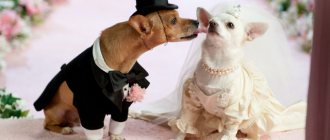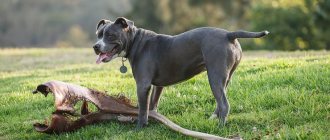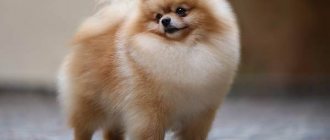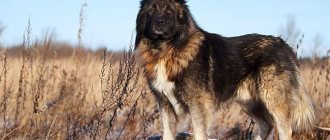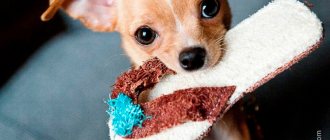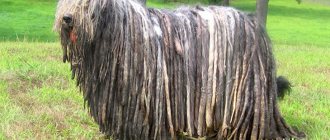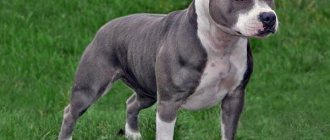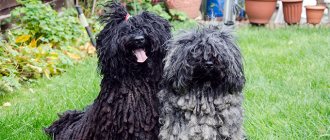Humanity began domesticating animals many thousands of years ago. Since then they have always been with us. The diversity of fauna is amazing. Among the popular representatives there are those that humanity has forgotten about. As a result of selection, new ones appeared that replaced the relict, aboriginal dogs.
Each dog has its own characteristics that distinguish it from others. This is influenced by the habitat, purpose, and conditions of detention. Preserving rare breeds means helping to expand the dog population. This also includes work on creating completely new offspring through selection.
How do new breeds appear?
In ancient times, dogs were used for hunting and home guarding. Therefore, in those distant times, people carried out a kind of selection according to these criteria. However, as human civilization developed, the requirements for animals began to change. For example, some hunters did not appreciate the white color of fox terriers. They began purposefully crossing different dogs and eventually got a black and tan Jagda.
When people needed guard and fighting animals, as a result of selection, more than one new breed of dog appeared. In China they were Shar-Peis, in Italy they were Cane Corsos.
To hunt in the vast expanses of the steppe, very fast dogs were needed, capable of overtaking a wolf, fox or hare. It was thanks to this that the Russian greyhound was bred.
American Hairless Terrier
The breed was approved in 2016. She appeared quite unusually and, one might say, by accident. There is information that the American Hairless Terrier first appeared in 1972 in Louisiana, when a rat terrier gave birth to a completely hairless puppy as a result of a genetic mutation. He became the first individual, which was later used for breeding a new breed.
ODIS
This abbreviation stands for Odessa Domestic Ideal Dog. Work on the creation of this breed began in the 70s of the last century. She was bred as a result of planned matings of a Fox Terrier, a Miniature Poodle and a Maltese. As a result, breeders managed to obtain a group of animals that were similar in phenotype and had common ancestors.
Like any other new breed of dog, ODIS has its own standard. These tiny animals grow up to 25 centimeters at the withers. Moreover, their weight is no more than three kilograms. The dog's miniature body is covered with thick, long, hypoallergenic hair of white, gray or light fawn color.
Representatives of this breed have a cheerful, energetic temperament. They have a fairly developed immune system that is resistant to infectious diseases. During their entire existence, veterinarians have not recorded a single case of severe pathologies or congenital deformities.
Unrecognized but popular young dog breeds
When purchasing a four-legged pet from this group, it is important to understand that the breeder will not be able to guarantee the character and appearance of his charges. You should also forget about participating in dog shows and other major competitions, as well as obtaining official documents for the animal. The latter is only possible if the breed is recognized at least at the national level.
Maltipoo
The Maltese-Toy Poodle hybrid was bred to produce a non-shedding pet for dog lovers with allergies. Quadrupeds gained popularity in the United States already in the early 2000s, and in Russia only 10 years later.
Maltipoos are very emotional and loving. They do not know how to regulate their feelings, which can irritate their owners. For this reason, it is better to take the Maltipoo into a large family, where it can receive a lot of attention.
“ More about the Maltipoo breed
Petersburg orchid
When breeding this variety, two criteria were adhered to: the presence of charm and the absence of the need for complex care. Experiments began in the early 1990s, but the first success occurred only in 1997.
Even after receiving a breeding patent from the Ministry of Agriculture in 2007, the breeder never disclosed information about the breeding sires. What is known is that they belong to toy breeds. This made it possible to maintain exclusive copyright.
INTERESTING!
At the insistence of the creator, the export of St. Petersburg orchids outside the home city and region is prohibited. Only rare sales abroad of individuals not suitable for breeding are allowed.
Despite their tiny dimensions (0.7-2 kg), St. Petersburg orchids are calm and not cowardly. They are distinguished by their innate trust in people and the ability to adapt to any lifestyle.
Pomsky
The most remarkable and youngest dog breed of the 21st century was created in the wake of artificially created hype. Photos of Pomeranian-Husky hybrids were leaked online even before the actual appearance of the dog itself. In fact, they featured photoshopped images of Alaskan Klee Kais.
Fearful of losing the public's interest, breeders quickly got down to business. The first litter was born in 2013, and an amateur club was organized in the USA for further breeding of these four-legged animals.
Despite its popularity, major cynological organizations do not recognize the Pomsky. The problem is exacerbated by the lack of a strict standard. Because of this, puppies are very different from each other in appearance. The Pomsky's character does not have clear requirements, so their behavior is unpredictable.
Do you like the article? 0
Russian salon dog
These decorative dogs appeared about fifteen years ago. They were bred by domestic livestock specialist Yu. A. Lakatosh by crossing a Yorkshire terrier, a pug and a Belgian griffin. Like any other new dog breeds in Russia, these miniature animals quickly gained popularity. They are ideal for keeping in a city apartment and have an open, easy-going character.
Unlike other decorative dogs, they have a powerful build and strong bones. On the rounded, short-muzzled head there are high-set ears, giving them a touching appearance. The animal's body is covered with long flowing hair, which requires careful care and regular grooming. The height of adult individuals is 18-28 cm. The weight of such a dog varies between 1.8-3.5 kg.
The Russian salon dog is easy to train, quickly remembers new commands and rarely shows aggression. This tiny pet gets along well with children and is able to get along in the same area with other pets.
Dogo Argentino
A beautiful, seasoned and very intelligent breed with strong bones and a muscular exterior. It first appeared in the early 1920s and was recognized a few months later. According to experts, the breed was specially bred for hunting large animals. The Dogo Argentino is not for everyone. Next to him there should be a person with a strong, but calm and strong-willed character.
Black Russian Terrier
Those who are interested in new breeds of dogs should know that these dogs were bred in the second half of the last century. Among the ancestors of the Black Russian Terrier are Airedales, Giant Schnauzers, Laikas, Great Danes, Rottweilers, Caucasian and German Shepherds.
Representatives of this breed are tall. Thus, adult males reach 68-74 cm and weigh 45-68 kg. Bitches are usually smaller. Their height is 66-72 centimeters, and their weight varies between 36-59 kilograms. On a massive, slightly elongated head with a heavy, square muzzle, there are high-set, drooping ears that fit snugly to the cheekbones. The dog's body is covered with thick, coarse black fur.
Like other dog breeds, including new ones, these animals were bred for specific purposes. First of all, breeders were interested in the dog’s protective qualities. Therefore, all Black Russian Terriers are loyal to their owner and his family members, but distrustful of strangers. These strong dogs are not intended to be kept in city apartments. They tolerate frost well and feel uncomfortable in the heat.
Black Terriers need long walks and exercise. They are quite trainable and quickly remember commands. However, in the process of raising a puppy, you need to remember that representatives of this breed require decisive and firm handling. To avoid getting an aggressive and suspicious dog later, you need to socialize it in a timely manner. It is advisable to do this at a very early age.
Grand Basset Griffon Wendeen
Another hunting breed that appeared in the 90s. Bred in the United States. The Grand Basset is distinguished by its bold character and excessive activity. This breed is definitely not suitable for keeping in an apartment, since the hunting instinct is present in the blood. The Grand Basset needs a lot of space and freedom. In addition, representatives of the new breed show a healthy interest in everything new.
East European Shepherd
These animals appeared relatively recently. The breeders used the German Shepherd as the basis. The development of a new breed of dogs began in the 30s of the 20th century. But the standard was officially approved three decades later.
These are quite large and strong dogs, weighing 30-60 kilograms with a height of 62-75 centimeters. They have a muscular build and strong bones. The body of the East European Shepherd is slightly stretched. On the large proportional head there are erect pointed ears. The animal's body is covered with thick, coarse hair. The East European Shepherd can be zoned gray, zoned red, saddleback, black and tan and black.
These dogs have strong protective instincts, so they are very distrustful of strangers. Animals are distinguished by loyalty, intelligence and nobility. East European Shepherds are very loyal to their owner and his family. They are highly trainable and require increased physical activity.
Azawakh
An incredibly beautiful and graceful dog that will be appreciated by true fans of purebred hounds. This breed has existed for thousands of years, but it was officially recognized only in 2022. These are extremely energetic and fast dogs with a highly developed hunting instinct. However, Azawakhs behave quite calmly and balanced indoors.
Poogle
For those interested in the newest dog breeds bred abroad, it will be useful to learn about the Beagle-Pug mix. These are not just random crossbreeds, but purposefully obtained animals with certain qualities. They perfectly combine intelligence and philanthropy.
These small dogs grow up to 25-37 centimeters. They do not require special care and do not carry the negative qualities of their ancestors. They don't have the independence of Beagles or the health problems associated with Pugs.
Kooikerhondje
Dutch Hunting Dogs appeared on the official list of the American Kenner Club in 2016. The breed became incredibly popular literally from the very first puppies, so to speak. Kooikerhondje is currently used with millet in North America. According to breeders, this breed needs an owner with a strong character and remarkable endurance, since the pet likes to walk a lot, explore new routes and cannot stay in one place for a long time.
Teddy Roosevelt Terrier
Despite the fact that these dogs appeared at the turn of the 19th and 20th centuries, they still have not received official recognition in the canine world. Before breeding a new breed of dog, breeders carefully selected pairs. Among the ancestors of these animals are beagles, Italian greyhounds and smooth fox terriers.
Representatives of this breed weigh between 1.5-3 kilograms and are no more than 32.5 centimeters tall. As for the color, it can be anything except fawn, cream and silver. Initially, these animals were bred for hunting, but now they are successfully used as companions.
Tuareg or African Greyhound
Quite a rare breed that appeared back in 1981. It was officially recognized only in 2016. The breed is popular in African countries, where it is used for hunting large game. The African hound easily overtakes gazelles, ostriches, jackals, hares and other mammals. The breed demonstrates excellent hunting skills, but at the same time behaves quite warily, and sometimes even aloof, with its owner.
A breed is a combination of specific external characteristics and certain behavioral characteristics. They cannot be ignored, since it will be difficult for a dog with a pronounced hunting instinct to find a common language with an elderly person who is used to spending most of his time at home. At the same time, there are breeds with a very aggressive character that will definitely not appreciate the company of small children. Therefore, when getting a pet, take into account its pedigree and character, determined by genetics.
We recently talked about how popular dog breeds have changed over time: some of them are not at all similar to modern pets.
Kava-poo-chon
This is one of the youngest breeds, developed by crossing the Cavalier King Charles Spaniel, Toy Poodle and Bichon. The breeders' plans included obtaining a small decorative dog with good health and hypoallergenic coat.
Kava-poo-chon is considered a very rare and expensive animal. Despite the fact that this breed has not yet been officially recognized, it has found its connoisseurs among ordinary owners.
Papillon
Dog with butterfly ears
The second name is continental toy spaniel. The maximum weight of a dog is 4.5 kg. A distinctive feature of Papillons is their ears, similar to the wings of a butterfly.
Representatives of the breed are smart and calm. Such a pet does not need long, active walks, preferring to lie next to the owner or on his lap. Papillons should be owned by families without small children, because miniature dogs will not tolerate intrusiveness towards them. As for strangers, pets make good little guards. Of course, with the right approach to training.
Other pets are considered by the Papillon as bad neighbors. But the toy spaniel does not show aggression towards them.
Methods for determining the age of dogs
The condition of the teeth is the most reliable “marker” of a dog’s age. The following parameters are assessed:
Up to 2 years of age, your pet’s teeth should be white: without black spots or spots. When examining the oral cavity there is no unpleasant odor.
At the age of 2 to 5 years, the shine of the teeth becomes dull, and slight wear of the incisors is noticeable.
Missing teeth is a bad sign. In a healthy dog, the natural process of tooth loss begins no earlier than 10 years of age, and in small breed pets even later - from 13 years of age.
Eyes
Clear outlines, shine and brightness of the eyes indicate the young age of the dog. A “sad” look, tears, and faded iris are characteristic of older animals. If such symptoms are diagnosed in a young pet, you need to urgently show him to a veterinarian. Such signs indicate illness.
Wool
It is not possible to accurately determine the dog’s age based on the condition of the coat, so this parameter must be taken into account in conjunction with the others. Wool is the most sensitive “marker” of a dog’s health. Allergies to food, seasonal shedding, changes in hygiene products, illness, irregular care - all this can affect the condition of the coat.
Hair loss is sometimes observed in young pets, but gray hair, especially on the face, indicates an old dog.
Musculature
By human standards, by the age of 1 year, dogs reach the development of a 14-15 year old. In the period from 1 to 2 years, the animal’s muscles are fully formed: this is noticeable by the distinct outlines of the croup, muscles on the paws and back, and taut belly. The pet radiates strength and vigor - just like young people aged 25-29 years. Depending on the breed and state of health, the animal remains in this form for up to 5-8 years. Miniature dogs maintain muscle tone longer than their larger counterparts in size and weight. This must be taken into account when determining the exact age of the pet.
Chihuahua
Chhunya is a lion's heart!
The most common small breed. The weight of the baby should not exceed 3 kg, otherwise the dog will not be able to take part in exhibitions.
The Chihuahua is a pet with a lion's heart. The dog adores its owner and is ready to do anything for him. The likelihood that a “chhunya” will attack a large dog or a person, deciding that they pose a threat to their beloved owner, is very high. And he won’t just bark, he’ll start throwing himself. To avoid this, representatives of the breed are recommended to be walked on a leash.
Many Chihuahuas have a choleric temperament. The processes of excitation prevail over the processes of inhibition, the dog is not able to switch quickly. When the baby gets overexcited, her eyes become huge, the pet shakes and may start barking. At such moments, it is necessary to talk to your pet in a calm voice, but it is not advisable to touch it.
An excited “sneeze” is capable of redirected aggression even if the owner is in front of him.
The company of preschool children is not recommended; they can be too friendly towards the dog and harm him. Chihuahuas are jealous, so they don’t tolerate other pets easily.
Dog age chart by human standards
It is not necessary to independently calculate how old a dog is by human standards; there is a special table for this. It determines the age of a dog based on its size.
| Number of years | Size | |||
| Small breed dogs | Medium sized dogs | Large | Gigantic | |
| 1 year | 15 years | 15 years | 15 years | 14 years |
| 2 years | 23 years old | 24 years | 22 | 20 years |
| 3 years | 28 years | 29 years | 29 years | 28 years |
| 4 years | 32 years | 34 years | 34 years | 35 years |
| 5 years | 36 years | 37 years | 40 years | 42 years |
| 6 years | 40 years | 42 years | 45 years | 49 years old |
| 7 years | 44 years old | 47 years old | 50 years | 56 years old |
| 8 years | 48 years old | 51 years old | 55 years | 64 years old |
| 9 years | 52 years old | 56 years old | 61 years old | 71 years old |
| 10 years | 56 years old | 60 years | 66 years old | 78 years old |
The data in the table does not always correspond to reality; there are exceptions. Thus, the age of a beagle dog (medium size) that has reached 1 year is equivalent to 20 human years.
In their development, dogs go through the same stages as other mammals:
- puppies (cubs);
- teenagers (average between a puppy and an adult dog);
- adult animal;
- old individual.
A dog is considered an adult when it reaches the age of 1 year.
How to determine the age of a dog by external signs
The situation is more complicated when the puppy is taken by a person, not a small one from a nursery, but a large dog from the street or a shelter. But there is also an approach here: they look at the condition of the teeth and eyes. A trip to the veterinarian will tell you how things are going with the condition of the internal organs. Examine the skin and fur.
When examining a new four-legged resident, it is worth doing an x-ray and an ultrasound; the veterinarian will interpret the results and make a verdict on the animal’s condition.
So, what do we look at carefully:
- Wool and skin in a flabby state, as well as gray hair, will clearly indicate the old age of the pet;
- A dog's vision - cloudy pupils and obviously poor eyesight is also not a description of a young puppy;
- Clean, undamaged teeth are characteristic of a young dog. Until two months the puppy has white milk teeth; after 7 months they are already permanent, but still white. The enamel gradually begins to darken and turn yellow, which means the animal has crossed the threshold of 7 months, but has not reached the age of two years. After 2 years, tartar is noticed on the teeth, and already from the age of five, wear on the surface of the teeth catches the eye. From the age of 10, dogs already noticeably lack some teeth and have a lot of tartar.
It’s still worth considering that the animal’s condition is also affected by its lifestyle, which it led before meeting its loved one.
Dog age: main periods of life
A dog's life depends on many factors
The life of dogs can be divided into 8 periods. In each of them, certain changes occur in the pet’s body and behavior. From birth to six months of a puppy’s life, his body is actively growing and developing. It is then that his character and behavior begin to take shape. Therefore, you need to carefully care for your pet, participate in its development and correct its nature.
Note! Those dogs that are properly cared for by their owners live to old age.
It is important for a novice dog breeder to know all periods of a pet’s life and the features of caring for it so that it lives long and happily.
The life of puppies can be divided into 5 stages:
- The first, which falls during the period from birth to 3 weeks. At this time, small puppies still do not see or hear anything at all, but are quite capable of finding nipples and feeding on their mother’s milk. Throughout this time, they sleep more, due to which they grow quickly and gain weight.
- The second period of life for puppies begins at three weeks and lasts up to a month. Babies begin to develop their first senses, such as smell and taste. They begin to leave their home and explore the area.
- In the third stage of life, which falls between one month and four months, puppies begin to be accustomed to independent living. But at the same time, they still need communication with peers - this will have a beneficial effect on the baby’s development. In addition, at this stage it is already possible to accustom him to the basic commands: “sit”, “lie down”, “to me”, “back”, “no”. And the main thing is that the puppy can already distinguish its owner from a stranger.
- At the fourth stage of life, namely from four to six months, the pet is accustomed to a collar and leash and taught new commands.
- At the fifth stage, which falls for a period of six months to a year, the puppy’s maturation ends. All the skills that he was taught all this time are reinforced.
Small breed dogs live much longer
Important! By communicating with other dogs, the puppy learns to identify possible danger and overcome it.
Young dog
In the period from one to three years, the pet begins to show attempts to dominate in the house and imposes its own line of behavior on the owner, showing aggression towards others. The person must show patience and perseverance to retrain the dog and show that he is the leader and the furry friend should obey him.
Adult dog
Dog age - from 3 to 8 years - falls on the 7th stage of life. During this period, the dog’s character is fully formed and its training is completed.
Old age of a pet occurs between the ages of 7 and 12 years. The dog becomes inactive and stops responding to commands. Loses hearing and vision.
Important! All this time, it is necessary to consult with a veterinarian in order to make aging easier for your furry friend.
How to calculate a dog's age
There are many methods that allow you to find out the age of a four-legged pet in relation to a human one.
But they are all quite arbitrary, since the life expectancy of a pet largely depends on the breed, nutrition, physical activity, the presence of chronic or congenital diseases, and the attitude of the owner. Up to 2 years, veterinarians use the following coefficients to calculate the ratio of dog and human age:
- small breeds – 1;12;
- medium breeds – 1:10;
- large pets – 1:9.
A one-year-old dog, especially small breeds, is an adult and can control its actions; for comparison, according to human criteria, this age corresponds to 10–13 years.
Table of the age ratio of people and dogs without taking into account breed
| Pet age (years) | Person's age (years) |
| 2 months | 1,2 |
| 6 months | 5 |
| 1 year | 10–13 |
| 3 | 28–32 |
| 5 | 38–42 |
| 7 | 47–50 |
| 8 | 54–57 |
| 10 | 63–66 |
| 12 | 73–77 |
| 15 | 85–88 |
| 16 | 87–90 |
| 20 | 94–97 |
Advantages and disadvantages of miniature breeds
Small dogs have the same trait - they are very active. Supports any games both at home and outdoors. And they also need to be walked, but the process takes a little less time. If you do not devote enough time to your pet, it is possible that it will become uncontrollable and even aggressive.
The main advantage is that you can take your four-legged animal with you. He will be allowed onto a train or plane, and you can go with him to visit or shop if necessary (sometimes you won’t even need to carry him). For some reason, simple care is usually considered an advantage, but no. Most fashion dogs require monthly grooming, treatment of nails, ears and teeth. List of advantages:
- cute appearance;
- small sizes;
- there are no special requirements for conditions of detention;
- low level of aggression and temper;
- do not need long walks;
- cannot cause damage (bite strongly, ruin repairs in the house).
Unfortunately, there are some downsides. The most obvious one is that many decorative breeds are difficult to train, especially if you are new to training. Some of them have a stubborn and capricious character and do not consider their owner to be a leader. Excessive emotionality may give the impression that your pet is nervous, but this is nothing more than a temperamental trait.
So, the smallest dog breeds are Chihuahua, Yorkshire Terrier, Boston Terrier, Bichon Frize, Maltipoo, Toy Terrier. Among the decorative ones there are also large representatives. Only the conditions of detention and care depend on the size, but in character, not a single baby is inferior to a large relative.
Don't forget that a small dog is also a predator. And she needs species-typical nutrition. The SUPERPET species-specific food according to the BARF system replicates the diet of predators in nature: 98% consists of raw meat without heat treatment, flavor enhancers and preservatives. Biologically appropriate nutrition normalizes digestion, prevents urolithiasis, kidney disease and other ailments. Suitable for sterilized pets of all ages and breeds. For those who really care about their pet's health!
Lebeau's theory
Exactly in the middle of the 20th century, a simple but accurate method was proposed for recalculating the age of a dog in relation to human years lived. As a French veterinarian, LeBe had a keen interest in everything related to dogs. He decided to understand their age nuances.
He calculated a number of coefficients that are influenced by indicators of overall life expectancy, puberty and the onset of maturity in comparison with people.
According to LeBeau, a one-year-old dog definitely matches the physical and mental state of a 15-year-old boy. In the second year of a dog's life, another 9 years will have passed by the standards of human life. Every year, starting from the third, adds another 4 years to the family friend.
global $ads_google; //data-ad-slot=”2475549904″ $ads_google = empty($ads_google) ? false : true; ?> if ($ads_google == false) {?>
$ads_google = true; ?> } ?>
Not everyone likes Lebeau's theory; it does not take into account the characteristics of the breed.
Small and medium dogs for apartment living
Most often, a small pet is purchased for a simple reason - it does not require much space. At home he will need a bed, although most likely the baby will spend time on the sofa next to the owner. It’s easy to take your pet with you on a trip or as a guest, placing it on your lap along the way.
Small dogs are divided into 3 groups depending on height and weight. The first includes toys whose weight does not exceed 2 kg and height 28 cm. The second includes dwarf ones with a weight of no more than 5 kg and height up to 35 cm. The third includes small ones, whose weight should not be more than 10 kg and height - 45 cm. Let's look at the photos and characteristics of the most popular breeds.
American Hairless Terrier
The hairless breed was developed in the 1980s in the USA.
Rarely cause allergies. The main feature is the absence of undercoat, which makes the skin vulnerable to the sun and cold. Positive character traits include energy, friendliness, and high intelligence.
Weight: 5–7.5 kg.
Height: 25–46 cm.
American Hairless Terrier.
Affenpinscher
A representative of pinschers, but only a very small one. It has dense hair on its face, which makes it look like a monkey. He has a very capricious character: jealous, independent and even slightly aggressive. Love deserves devotion - the Affenpinscher does not tolerate loneliness and is ready to stay with its owner 24 hours a day.
Weight: 4–5 kg.
Height: 25–30 cm.
Affenpinscher.
Belgian Griffon
One of the dog breeds that is suitable for older people. Griffons are calm, not prone to escape, and prefer to stay close to people. With all this, they are quite cheerful and inquisitive, and also need training, like all dogs. The peculiarity is that the griffon behaves differently with different people.
Weight: 3.5–6 kg.
Height: 18–20 cm
Belgian Griffon.
Bichon Frize
Amazingly cute and plush pets that won't let you sit still. The Bichon Frize is a French lap dog. Despite their thick coat, they have no odor and do not shed, which is why they are considered hypoallergenic. They get along well with children and animals, but cannot tolerate long absences from their owner.
Weight: 2.5 kg.
Height: 25–30 cm.
Bichon Frize.
Boston Terrier
A friendly, loyal and disciplined breed, developed by crossing an English Bulldog and a Terrier. That is why the tailed cat has an interesting appearance: a flattened muzzle, protruding long ears, large eyes. Unlike bulldogs, the Boston Terrier does not drool, and its behavior is worthy of respect.
Weight: 3–10 kg.
Height: 24–28 cm.
Boston Terrier.
Brussels Griffon
A sociable brownie will not allow you to be alone. The Brussels Griffon prefers to choose only one person (and not always the owner) and follow him everywhere, waiting for a portion of affection. The miniature size does not prevent the pet from being a guard. The average life expectancy reaches 13–15 years.
Weight: 3–5 kg.
Height: 18–20 cm.
Brussels Griffon.
West Highland White Terrier
A playful and inquisitive companion - he will remain so until his old age. He will not tolerate rodents nearby, but he is quite friendly with cats and dogs. When walking with your pet, you need to be more careful, as the West Highland White Terrier does not mind digging in the flower beds. Amenable to training and education.
Weight: 6–10 kg.
Height: 23–30 cm.
West Highland White Terrier.
Havanese Bichon
Another companion breed that is exclusive. The Havanese Bichon is a tactile and tame dog that will get along with anyone. The breed is recommended for those who can spend a lot of time next to the tailed one, since the Bichon does not tolerate loneliness. Life expectancy is up to 10–12 years.
Weight: 3–5 kg.
Height: 23–28 cm.
Havanese Bichon.
Yorkshire Terrier
Perhaps the most famous breed of decorative dogs, with an affectionate and flexible character. At the same time, he is distinguished by courage, energy and intelligence. Always happy to run, so it's perfect for families with children. Yorkies are capable of learning many commands, but sometimes due to restlessness, training takes a long time. With proper care, the terrier will delight you for 13–15 years!
Weight: 2–3.5 kg.
Height: 15–17 cm.
Yorkshire Terrier.
Cavalier King Charles Spaniel
We have reached another good-natured breed, whose representatives are always cheerful and cheerful. The King Charles Spaniel will see a true friend in every person. The only negative is that the tailed one will not tolerate loneliness and lack of attention (it may even act out). Kings have retained their hunting instincts, although they get along well with small animals.
Weight: 5.5–8 kg.
Height: 28–32 cm.
Cavalier King Charles Spaniel.
Chinese Crested Dog
This is a very unusual, but very beautiful indoor breed of dog. It can be downy or hairless. Pets are often called stress relievers - they love tactile contact with humans so much. It is unacceptable to keep a Chinese Crested outdoors, because bare skin does not tolerate temperature changes well. A representative of the breed will not let you get bored - he will even get a little bored with love for both people and animals in the house.
Weight: 2.3–5.5 kg.
Height: 23–30 cm.
Chinese Crested: hairless on the left, downy on the right.
Lhasa apso
Suitable for all lovers of Tibetan dogs, because the Lhasa Apso is their smaller version. The appearance is striking: rich silky fur that hides the eyes, a button nose, miniature size. Not everything is so good with character, although the Lhasa Apso has high intelligence, courage and kindness. The pet will not tolerate strangers - it can bark at guests, but on foreign territory it will behave with restraint.
Weight: 5.5–7 kg.
Height: 20–25 cm.
Lhasa Apso.
Maltese
The Maltese is a living soft toy that has a truly doll-like appearance. Loving, friendly, sociable. It requires love and time from a person: caring for snow-white fur takes a lot of effort. The Maltese is only becoming more popular - its cute appearance and ideal character make you fall in love with the tail, especially since it can live up to 15 years.
Weight: 3–4 kg.
Height: 20–25 cm.
Maltese.
Maltipoo
One of the few breeds that is still not recognized by international canine associations. The Maltipoo is a mixed breed that carries the genes of the Toy Poodle and the Maltese. Until old age, your pet will surprise you with its activity and gullibility. You need to take into account the loud voice, because the baby Maltipoo loves to give it in any situation.
Weight: 2.5–5 kg.
Height: 20–30 cm.
Maltipoo.
Mini bull terrier
Standard bull terriers are problematic to keep in an apartment, but mini ones are fine. The compact build has virtually no effect on the character of the quadruped. This is still the same brave, stubborn and wayward dog that requires a special approach. A minibull will become a wonderful friend, companion and even a family protector, but it will not be suitable for home guarding.
Weight: up to 8 kg.
Height: 25–35 cm.
Mini bull terrier.
Pug
One of the ancient breeds (but inexpensive!), which has retained the character traits and appearance of its ancestors to this day. Pugs are not prone to aggression - they are soft and sociable pets that find a common language even with strangers on the street. Between a walk and relaxing on the couch with the owner, they will choose the latter, but they still need to be trained (albeit through dissatisfaction).
Weight: 6–7.8 kg.
Height: 28–32 cm.
Pug.
Norwich Terrier
An incendiary, curious and sociable friend, surprising with an inexhaustible supply of energy. Norwich will be against playing with children, but it will like strict and responsible adults. Terriers need long and active walks - couch potatoes obviously will not make friends with a Norwich.
Weight: 5.5 kg.
Height: 24–26 kg.
Norwich Terrier.
Papillon
Papillons are often called continental toy spaniels, since they originated from them. Easy-going, playful and moderately independent pets. They can boast of ingenuity, developed intelligence and good nature, but at the same time they are jealous and domineering. Sometimes they show aggression towards other animals, they can even bite, but they are calm towards people. Papillons cannot see life without regular exercise.
Weight: 3–5 kg.
Height: 20–27 cm.
Papillon.
Pekingese
It is difficult to find people who have never been touched by the Pekingese. This four-legged friend has a very funny appearance: a flattened muzzle, shaggy long hair, short legs and an elongated body. The Pekingese is a very peculiar creature that does not have the simplest character. Peaceful, but prefers to stay away from animals. Like all breeds, it requires walking, although it often refrains from active games.
Weight: 3.3–5.4 kg.
Height: 17-25 cm.
Pekingese
Petersburg orchid
The name speaks for itself: the breed was bred in St. Petersburg and is the author’s own. Orchid is a fashion dog that can only live in an apartment. Combines the best qualities: sociability, positivity, perseverance. In appearance it is somewhat reminiscent of a Yorkie, but the character is completely different.
Weight: 2–4 kg (lightweight from 700 g).
Height: 17–30 cm.
Petersburg orchid.
Pomeranian Spitz
The Spitz, a small dog that cannot live without its owner, will definitely cause you sincere affection. He becomes so attached to a person that even separation for a couple of hours makes the baby nervous. It can become a companion for children, but at the same time has watchdog qualities. Be sure to devote time to training - without proper attention, the Spitz will become stubborn and disobedient.
Weight: 1.5–3.2 kg.
Height: 18–22 cm.
Pomeranian Spitz.
Pomsky
Everyone knows that keeping huskies in an apartment is not the best idea - they vitally need freedom and space. But Pomskies (a mix of Husky and Spitz) are available for keeping in the city. They bear the features of two breeds at once, but still it is more of a decorative and tame pet. There are still few puppies of this breed, so not every dog handler will undertake training, which means Pomskies are definitely not suitable for beginners.
Weight: 5–7 kg.
Height: up to 40 cm.
Pomsky.
Prague rat
The Czech Pied Piper today is a fashionable pet - it decorates the house and gives people joy with its presence. The tailed one will surprise you by the fact that, decades later, it has retained the hunting instincts of its ancestors. The toy's dimensions (the puppy's size is often smaller than the palm of your hand) do not interfere with the rat's ability to protect the home and owner. It scares away the enemy with a loud bark, but the pet never becomes aggressive. Remember that representatives of this dog breed are athletic creatures that need daily training.
Weight: 2–2.2 kg.
Height: 19–23 cm.
Prague rat.
Petit Brabançon
A decorative dog with a touching appearance: a flattened nose, slightly visible teeth, tiny paws and large ears. Unlike most of its small relatives, the Petit Brabançon has a balanced and reserved character. He will never rush unless there is a reason. An inquisitive pet of this breed tries to stay close to its owner, and lack of attention can greatly offend the baby. In terms of intelligence, a tailed cat can be compared to a three-year-old child - training will not take much effort from you.
Weight: 3–5.5 kg.
Height: 16–25 cm.
Petit Brabançon.
Poodle (small, miniature and toy)
When you think of the most elegant and intelligent dog, the one that comes to mind, of course, is the poodle. Curly and soft fur, small eyes and an elongated muzzle are the main differences. In addition, the four-legged friend is characterized by obedience, high intelligence, and activity. Despite its plush fur, it is easy to care for. Endowed with special kindness to children and animals.
Weight: from 2.5 to 8–13 kg depending on the type.
Height: from 24 to 45–50 cm.
Miniature Poodle.
Toy Terrier
If you want an energetic and loyal companion, then the red toy terrier is waiting for you. He will surprise you with his emotionality, affection, and desire to make friends with everyone. However, problems may arise with training - the stubborn nature will not allow the owner to control the pet. The only downside is the lack of stress resistance.
Weight: 1.4–3 kg.
Height: 20–28 cm.
Toy Terrier.
Chihuahua
Once again, the most popular breed of babies in the world is the Chihuahua. They know how to make anyone fall in love, not even a dog lover. The tiny size (the pet will grow up to a year) will not prevent your four-legged friend from acting like a big dog. The Chihuahua is so brave that it can even bark at a shepherd, and at the same time it gets along well with all animals. Loneliness, demandingness and rudeness on the part of the owner will “kill” the pet. The breed is jealous and prefers to monitor every action of a loved one.
Weight: 0.5–3 kg.
Height: 15–23 cm.
Chihuahua.
Shih Tzu
The Shih Tzu is a dog breed with Asian roots. Its representatives have a balanced, calm and at the same time strong character. Its cute appearance (long, incredibly soft fur and small size) gives the impression that this is a living toy. In fact, he is a reserved, intelligent dog with a stable psyche. The only thing that will unbalance him is loneliness, which can cause depression.
Weight: 4–7 kg.
Height: 23–27 cm.
Shih Tzu.
Japanese Chin
One of the purebred and rare breeds is the Japanese Chin, a companion dog suitable for living in an apartment. It amazes with grace, elegance and developed flair. Friendly with pets and people, but does not like children under 5 years old. It should be added to the description that the chin does not bark - it makes sounds similar to a cat's meow.
Weight: 2–4.5 kg.
Height: 20–27 cm.
Japanese Chin.
Japanese Spitz
Much larger than the Pomeranian, and the character is different. The Japanese breed is calmer, easy to train and suitable even for novice dog breeders. His feelings are greatly influenced by the mood of the owner, and loneliness makes him behave inappropriately. Alas, the Japanese Spitz does not have a hunting instinct - it obviously will not guard the house.
Weight: 5–8 kg.
Height: 28–35 cm.
Japanese Spitz.
TOP 10 most beautiful big dogs
It’s easier for a big dog to be beautiful; there’s something for the eye to focus on. But choosing the most beautiful among them is very difficult, since each breed is unique in its own way. TOP 10 is a relative number, because there are many more beautiful dogs, even if we strictly rely on the canons. If you can't find your favorite breed in the list below, don't worry. This list does not exhaust the topics completely.
Pyrenean mountain dog
The breed belongs to the aboriginal dogs of the mountainous regions of France. This ancient European breed was brought to Europe from Central Asia before the beginning of the era along with nomadic shepherds. During the French Revolution, the tribe suffered greatly; they tried to breed the dogs because they belonged to the nobility. The breed is large, majestic and powerful. Sometimes the height of the Pyrenees reaches 80 cm at the withers. Main parameters: male height - 70-80 cm , weight - 50-54 kg ; female height - 65-75 cm , weight - 36-41 kg . Life expectancy is 10-12 years. It is better to entrust the choice of a puppy to the breeders. The dog requires serious care and education.
Bernese Mountain Dog
The massive dog charms his family with his smile. Exactly! And its impressive size does not hinder this in any way. Bern has an excellent character, he is even friends with cats. The dog's bright color and beautiful powerful build are impressive. His ancestors were Roman fighting dogs. The breed was finally formed in Switzerland. Main parameters: height of males - 64-70 cm at the withers, weight - 39-50 kg ; height of females - 58-66 cm at the withers, weight - 36-38 kg . When choosing a puppy, special attention is paid to the elbow and hip joints; genetic pathology is possible.
Irish Setter
The magnificent Irishman is elegant and stately. The main decoration of the dog is its mahogany-colored silk coat. The dog has an excellent character and a flexible mind. The Irishman is playful, dexterous and kind. The main character trait is shyness . The breed takes its origin from the English Setter. This is the youngest breed of the family. The Irishman's dimensions are significant: male height - 58-67 cm , weight - 27-32 kg ; female height - 55-62 cm , weight - 24-29 kg . Life expectancy is 12-15 years . When choosing a puppy, pay special attention to the coat and ears. They must be flawless.
Hungarian Kuvasz
A beautiful white dog originally from Hungary. This is a powerful and strong dog with a serious character. The breed was bred for protection purposes, which affects its habits. Main parameters: male height - 70-76 cm , weight - 45-52 kg ; female height - 65-70 cm , weight - 32-41 kg . Life expectancy is 10-12 years . Owning such a dog is recommended only to experienced dog breeders, since the dog requires serious training.
Russian greyhound
You can't calmly walk past this dog. Outwardly, it strongly resembles a Saluki, but its smooth coat ruins the resemblance. The Russian dog is a true aristocrat. This can be seen in appearance and habits. The breed was thoroughly recognized only at the end of the 19th century . Main parameters: male height - 75-85 cm , weight - 34-47 kg ; female height is 68-78 cm, weight is 25-40 kg. Life expectancy is 7-10 years . When choosing a puppy, pay special attention to the baby's bone structure. Pedigree research is definitely required.
German dog
The giant dog was once bred in Germany. The breed is extraordinary and complex. The dog was bred gradually, combining different breeds into a whole - boar dogs, bulldogs, English mastiffs. Literally, “Dogo” means “giant”; this had nothing to do with the breed. In the 19th century, Great Danes were classified by color. This is how the German representative received his personal status. Its dimensions are impressive: males - up to 90 cm at the withers with a weight of up to 79 kg ; females - up to 84 cm at the withers with a weight of up to 63 kg . Their lifespan is on average 8-10 years . The puppy is taken into the home no earlier than he is 3-5 months old. Particular attention is paid to the skull. In profile, the nasal canal and the axis of the skull should be parallel. However, parallel lines must be present throughout the entire body - well-fed and strong.
Akita Inu
This dog certainly has charisma. You can look at her for a long time without feeling the desire to turn away. Something elusive attracts this dog. Akita Inu comes from Japan. It seems that the dog has literally absorbed Japanese culture. This can be seen in the movement and in the character of the animal - calmness and firmness. A powerful body, thick hair and wise slanted eyes are the external features of the dog. Main parameters: male height - 64-70 cm , weight - 45-59 kg ; female height - 58-64 , weight - 32-45 kg . Life expectancy is 10-12 years. When choosing a puppy, pay special attention to the eyes; they are most susceptible to diseases.
Hungarian pointer
Another ancient breed. Her homeland is Hungary. The ancestors of the Hungarian Vizsla were hounds, which were later crossed with strong and hardy breeds. The dog is smart, beautiful and loyal. Posture is excellent. Easy to learn. Main parameters: male height - 56-64 cm , weight - 20-29 kg ; female height - 53-61 cm , weight - 18-25 kg . Life expectancy is 12-15 years. When choosing a puppy, evaluate the available space; the Hungarian Pointer requires space.
German Shepherd
Germany is recognized as the homeland of the magnificent dog. This is the smartest service dog, distinguished by its unique grace and strength. His eyes are especially captivating. The breed is recognized as one of the most intelligent. Main characteristics: male height - 60-65 cm , weight - 30-40 kg ; female height is 55-60 cm , weight is 22-32 kg . Shepherd dogs live on average 9-13 years . When choosing a puppy, the main attention is paid to its behavior. He should be playful with a strong build.
Podenco Ibicenco (Ibizan Greyhound)
An elegant hunting dog, thin and slender. The Ibizan is a direct descendant of the Middle Eastern greyhounds. Outwardly it resembles an Egyptian dog. The dog is active and very jumping. They say they even climb trees. The breed is smart, but requires serious training. Consider this when choosing a puppy. Main parameters: male height - 66-72 cm , weight - 20-30 kg ; female height is 60-67 cm , weight is 20-30 kg . Life expectancy is 10-12 years .
